June 11, 2021
Air Date: June 11, 2021
FULL SHOW
SEGMENTS

The Golden State Going Greener
View the page for this story
California has often led the nation in environmental ambition, and now that his state finds itself with a big budget surplus Governor Gavin Newsom wants to invest $14 billion of it in climate initiatives. That would help make progress on the state’s ambitious goal of net zero carbon emissions by 2045. Jared Blumenfeld is the secretary of the California Environmental Protection Agency and host of the podcast, Podship Earth, and he joins Living on Earth Host Steve Curwood to discuss offshore wind, environmental justice and more. (10:58)

Beyond the Headlines
View the page for this story
On this week's trip Beyond the Headlines, Environmental Health News editor Peter Dykstra joins Living on Earth’s Bobby Bascomb to talk about some unexpected opposition to a solar facility in Florida, and in the Mojave desert, efforts to prevent a solar project there from harming the sensitive desert tortoise. Finally, celebrate a moment in history as the pair remember the million-dollar settlement in a fight for clean water that inspired the box office hit “Erin Brockovich”. (03:39)

The First All-Electric Ford Pickup
View the page for this story
Ford’s F-series are the best-selling vehicles in the United States. Now the all-electric version of the popular F-150 is making quite a storm in the auto industry and among aficionados. Jim Motavalli, freelance writer and blogger for Car Talk, joins Host Steve Curwood to talk about the future of the electric pickup in America's car market. (11:20)

The EV RX
View the page for this story
Compared to those that use fossil fuel, electric vehicles like Ford’s new F-150 Lightning truck are better for the environment. Now, new research suggests that EVs are also better for our health. Prof. Jack Spengler from the Harvard T.H. Chan School of Public Health joins Host Steve Curwood to discuss how a reduction of particulate matter pollution thanks to EV adoption could reduce mortality and improve health outcomes. (06:39)

Backup: African Elephant and Chacma Baboon
/ Mark Seth LenderView the page for this story
Near dawn at a waterhole in Motobo National Park, Zimbabwe, a young elephant makes the mistake of bothering a band of baboons. Living on Earth’s Explorer-in-Residence Mark Seth Lender relives the encounter. (03:33)

Running Buffalo Clover
/ Glynis BoardView the page for this story
For nearly half a century, Americans believed the running buffalo species of clover to be extinct, until a biologist discovered the plant on a hike 30 years ago. Glynis Board from the Ohio Valley ReSource reports from West Virginia on efforts to try and encourage the growth of the endangered species. (03:44)
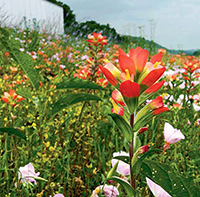
Roadsides as Vital Habitat
View the page for this story
Some 17 million acres of green space line US highways and byways, and it’s vital habitat for pollinators, as well as small voles and mice and birds. Bonnie Harper-Lore, a restoration ecologist formerly with the Federal Highway Administration, tells host Steve Curwood about the value they offer to wildlife and how President Lyndon Johnson’s wife, Ladybird, helped uplift this elongated haven for creatures and wildflowers. (07:49)
Show Credits and Funders
Show Transcript
HOSTS: Steve Curwood
GUESTS: Jared Blumenfeld, Bonnie Harper-Lore, Jim Motavalli, Jack Spengler
REPORTERS: Glynis Board, Peter Dykstra, Mark Seth Lender
[THEME]
CURWOOD: From PRX – this is Living On Earth.
[THEME]
CURWOOD: I’m Steve Curwood.
They call California "The Golden State" and it’s hoping its big budget surplus will help catalyze a green revolution.
BLUMENFELD: This year ahead is really important for us. We are writing the roadmap for 2045 carbon neutrality. And I think the budget that Governor Newsom put forward is a down payment on that carbon neutral future. It's saying, we have the money now to do some big bold things, we need to do them, and we need to keep pushing forward.
CURWOOD: Also, the enormous value of roadsides and highway median strips as pollinator habitats.
HARPER-LORE: The area between the pavement and the right of way fence on county, state, and interstate highways adds up to a total of 17 million acres – possibly millions of acres of conservation opportunity.
CURWOOD: That and more this week on Living on Earth – Stick Around!
[NEWSBREAK MUSIC: Boards Of Canada “Zoetrope” from “In A Beautiful Place Out In The Country” (Warp Records 2000)]
[THEME]
The Golden State Going Greener
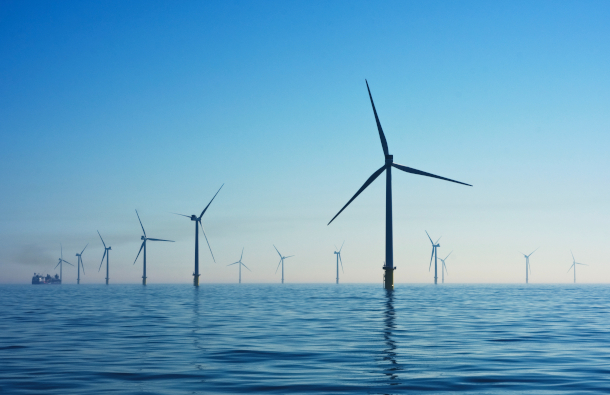
Turbines in the Rampion Offshore Wind Farm in the United Kingdom. In May 2021 the Biden administration and California Governor Gavin Newsom announced plans to open up the West Coast to offshore wind development for the first time. (Photo: Nicholas Doherty on Unsplash)
CURWOOD: From PRX and the Jennifer and Ted Stanley Studios at the University of Massachusetts Boston, this is Living on Earth. I’m Steve Curwood.
California has often led the nation in environmental ambition, and just recently Governor Gavin Newsom set a goal of phasing out Golden state oil and gas extraction by 2045. That would help California reach its goal of net zero carbon emissions, also by 2045 and it’s already heading there. Per capita carbon emissions have fallen nearly 30% in the last two decades, and right now the Golden State suddenly has plenty of gold or rather cash thanks to a huge budget surplus. And the Governor wants to invest some of it in a greener future. Jared Blumenfeld is the secretary of the California Environmental Protection Agency, and hosts the podcast, Podship Earth. He’s on the line now from Sacramento. Welcome back to Living on Earth, Jared!
BLUMENFELD: Hey, Steve, it's great to be with you. I always enjoy getting to talk with you.
CURWOOD: It's a mutual pleasure. So California has some $75 billion right now in budget surplus. How is Governor Newsom planning to direct some of that money towards climate solutions? What's at the top of the list?
BLUMENFELD: Top of our list, Steve, is climate change, climate resiliency. We're looking at everything from putting money into helping recycled water and drinking water, all the way through, really doubling down our commitment to achieve zero emission fleets within our vehicles. The governor set a goal of getting all new car sales to be zero emission vehicles by 2035. But we also put a lot of emphasis on helping with trucks and cleaning those up as well, all the way through things about how we make agriculture more climate friendly, and how we sequester carbon into the soil, to things like how we work with schools to increase broadband, which can also help with reducing commute trips and things like that. So we put about $14 billion into the climate budget. And importantly, you know, we had three frames that we looked at this really historic opportunity: equity, measurable health benefits, and reduction in pollutants -- climate gases, or criteria pollutants or just toxins. So those are the three things we looked at. And our estimation is 60% of the money in this budget is going to go to disadvantaged communities. That's our goal. So we're very intentional about making sure that the money goes to those who need the help the most.
CURWOOD: Now recently, Governor Newsom announced a rather ambitious offshore wind plan. Tell me more about that.
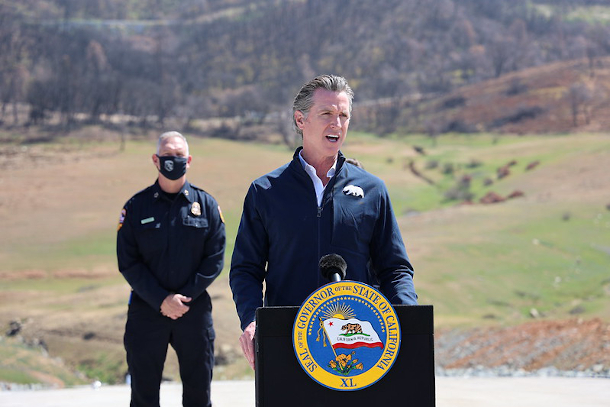
Governor Newsom is proposing $14 billion in funding for climate action and adaptation. (Photo: CALFIRE_official, Flickr CC BY-NC 2.0)
BLUMENFELD: So Steve, if you think about where we are as a planet, I mean, you hear a lot about the existential crisis that climate presents. And, and I think what California has done over a multitude of decades, is really legislate and innovate our way to a place where we can both grow the economy and reduce our greenhouse gas emissions. And that's what the rest of the world is looking at. And one of the sectors we've been incredibly aggressive on -- and we have this dashboard online, that you can see how much renewable energy is feeding the grid in California at any time, and two weeks ago it was that 95% of all the energy comes from renewable sources. So it shows what is possible, right?
CURWOOD: Wait, wait, wait, wait -- 95% of California's energy now coming from renewable resources?
BLUMENFELD: There was a time -- So Steve, this isn't permanent, like in an average year.
CURWOOD: Oh, just for a moment. Yeah, all right.
BLUMENFELD: For a moment, right. But it was a Saturday afternoon and the sun was out. And so we needed not too much energy, and we were getting a lot from solar, and so yeah, it shows the potential. As a state, we're at about 63% is non-fossil fuel. But that still includes today, things like nuclear power and hydro, and we need to move to a place where it's fully renewable 100% of the time. And so when you look at where we get our renewable energy from, it's from two sources: solar, and onshore wind. And the profile, namely, when people need power versus when the sun is shining or the wind is blowing, don't always align. But when you look at offshore wind, which the big announcement was made between the federal government and Gavin Newsom, offshore wind can really fill in that gap. And it's a pretty big deal, like the amount of the ocean that they're dedicating is about 400 square miles. And they estimate that it will be able to produce about four gigawatts, 4000 megawatts of power, which is enough to produce energy for about 3 million homes. So really, really historic day, big deal, big industry for the labor movement, a lot of jobs, a lot of investment. I think it's really the beginning of a turn, which is that businesses can really see that they can make money, consumers can see the real return in things like reliability, and we can achieve our carbon reduction goals.
CURWOOD: So to do this much offshore wind, how dependent is it on the promise that President Biden is making of installing nationwide, some 30 gigawatts of offshore wind?
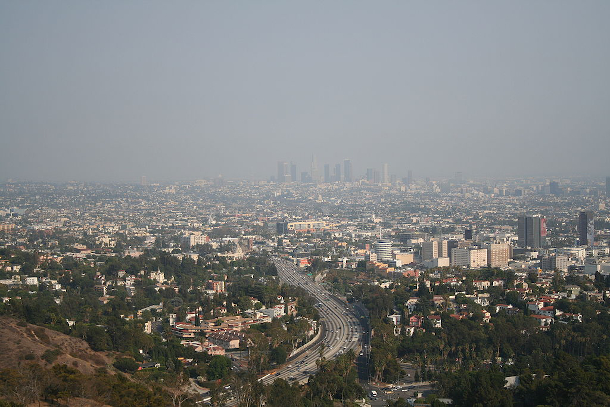
California is home to 7 of the 10 cities in America with the dirtiest air, and black and brown communities are most impacted by air pollution. (Photo: Massimo Catarinella, Wikimedia Commons CC BY-SA 3.0)
BLUMENFELD: I mean, Steve, it is just, you know, often people say, doesn't really matter who the President is. It really matters who the President is! And President Biden has come in, I think, with an incredibly comprehensive jobs and climate package. He's really said, we need to do all of the above and do it quick. So in a matter of months, you know, we were banging our heads against the wall and folks at the California Energy Commission had tried and tried and tried to get the Department of Defense and Interior together, and nothing had happened for four years. I mean, basically Trump did nothing. In four months, the team came on and said, we're gonna make this happen. We're, committed to making it happen. And amazingly, they did. So it takes political leadership to make bold change. We have no choice but to respond to the climate emergency we're in. And it's really, really heartening to have the federal government supporting. I mean, just to give you the contrast, in the Trump administration, we had more than 70 lawsuits just on the environment against the Trump administration. We're now able to roll many of those back. And rather than spend time on legal bills, we're now able to look forward and develop innovative programs. So their help on everything from the clean car standards to how we're thinking about offshore wind has been invaluable.
CURWOOD: Now, President Biden has what he calls a Build Back Better plan in the wake of the economic destruction of the pandemic. Your Governor, Gavin Newsom, is talking about a California Comeback Plan. And there are many elements of this. But Jared, let me ask you, in particular, how does this comeback plan address the matter of environmental justice?
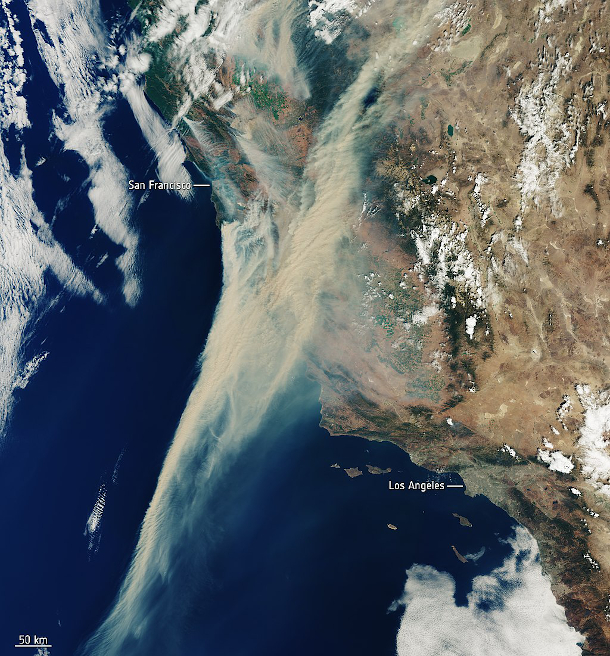
This European Space Agency image from August 19th, 2020 shows smoke from fires ablaze in California. Climate change is exacerbating drought and warmer temperatures in the state, creating dangerous conditions that allow fires to ignite and spread. (Photo: European Space Agency, Wikimedia Commons CC BY-SA 3.0 IGO)
BLUMENFELD: So really, there will be no climate solution, Steve, without making sure environmental justice is also addressed. And you know, environmental justice is environmental racism. Often people don't want to say that. But California has led with this tool, a GIS mapping tool called CalEnviroScreen, if you look up CalEnviroScreen, it looks by census tract. And basically what you see, even in a state like California that prides itself on being progressive, is black and brown communities and low income communities suffer worse environmental pollution than whites in the state, period. And this is completely unacceptable. And I think it's on all of us to make sure that as we're thinking about climate solutions, we're thinking about environmental justice. And in that context, our budget is very focused on making sure that we're funding the things that need and have the greatest impacts in the communities that are overburdened. So an example would be, we're not just saying, we want more electric vehicles that are passenger vehicles, because often those go to wealthy communities like San Francisco or LA. What we're saying is we need to get rid of polluting diesel trucks, that are going from the port of LA and Long Beach to the Inland Empire, we need to get rid of polluting diesel school buses, we need to get rid of polluting tractors and, and vehicles on the farm that hurt rural communities. So in every one of our investments in this $14 billion climate budget, in every single one, we want to make sure that the majority of the funding is going to help communities of color overcome historic burdens. And so this budget really commits to things like $500 million to clean up brownfield communities, another $500 million to deal with a single lead acid battery facility where the company Exide walked away and tried to use bankruptcy to get out of their obligations. So time and time again, I think our budget is focused on, on communities that are on the front lines.
CURWOOD: Look ahead, just 12 months, just one year. What are you hoping, expecting, to have accomplished now, in the comprehensive climate and environmental action plans that we've been talking about here?
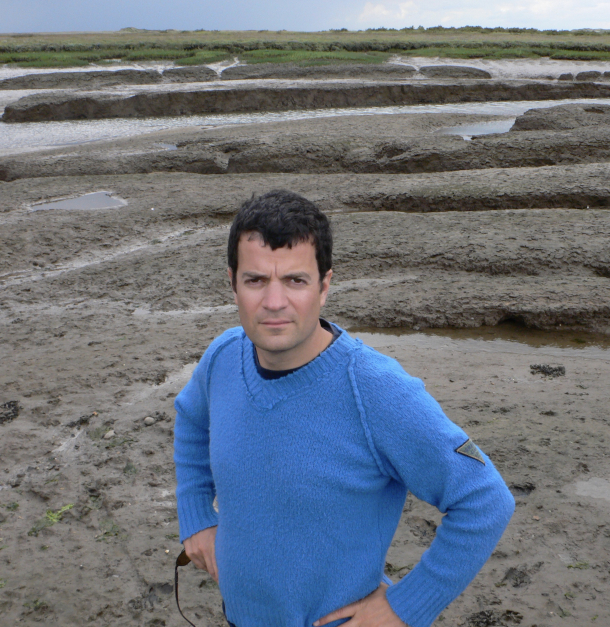
Jared Blumenfeld is California’s Secretary of Environmental Protection and the host of the podcast, Podship Earth. (Photo: Courtesy of Jared Blumenfeld)
BLUMENFELD: This year ahead is really important for us. We are writing the roadmap for 2045 carbon neutrality. What are all the policies that need to be in place? How stringent do they need to be? What are the funding that needs to go behind those? How do we make sure we integrate environmental justice into every element of our planning? How do we think about the just transition of oil field and fossil fuel workers? How do we make sure that each community has the charging infrastructure for electric vehicles? How do we make sure that buildings are designed so that they don't need fossil fuels to run them, all those things are going to be in this scoping plan. That is our blueprint, our roadmap for getting to 2045 carbon neutrality. At the same time, it's really thinking about, what are the big things that we can do now, that will impact the future? And I think the budget that Governor Newsom put forward is a downpayment on that carbon neutral future. It's saying, we have the money now to do some big bold things. We need to do them. And we need to keep pushing forward. Because the science tells us -- and actually you don't need to be a scientist to live in California and know that climate change is real, when you have wildfires that are already starting up as early as May and have a historic drought. So we are looking at how we become resilient. How we make sure that the most vulnerable among us, is the best prepared to deal with the realities of climate change that we probably won't be able to change.
CURWOOD: Jared Blumenfeld is the California Secretary for Environmental Protection and the host of Podship Earth. Thank you so much for taking the time with us, Mr. Host and Mr. Secretary.
BLUMENFELD: Thank you, Steve. Always a pleasure and thank you for doing what you do.
Related links:
- Find Podship Earth here or wherever you get your podcasts
- About the California Comeback Plan
- NYTimes | “Biden Opens California’s Coast to Wind Farms”
- Find CalEnviroScreen and learn more about environmental justice in California
- Jared Blumenfeld is the California Secretary for Environmental Protection
- Listen to a previous Living on Earth conversation with Jared Blumenfeld
[MUSIC: Steely Dan “Gaslighting Abbie” on Two Against Nature, Giant Records]
Beyond the Headlines

A solar project in Archer, Florida is causing an environmental justice conflict between residents and the Alachua Board of County Commissioners. (Flickr, CC BY 2.0)
CURWOOD: It’s time for a trip Beyond the Headlines with Peter Dykstra. Peter is an editor with Environmental Health News, that’s ehn.org and dailyclimate.org. He spoke with Living on Earth’s Bobby Bascomb.
BASCOMB: Hey there, Peter, what do you have for us this week?
DYKSTRA: Well, hi, Bobby a couple of stories about solar energy running into opposition in unexpected places. The first one is a northern Florida town near Gainesville, and the University of Florida. The town of Archer is a historically black community with a cemetery that dates back to the 1830s. They're about to become neighbors with a solar facility that, they feel, would disrupt the historic nature of the town and the cemetery. They're dead set against it. It's a conflict between environmental justice and clean energy that's kind of unexpected.
BASCOMB: Well, that is unexpected and of course, the Biden administration has made both those things really important goals: clean energy and getting to net zero emissions in the next couple decades, as well as environmental justice. You know, not making minority communities bear more of the burden than they already have in the past. That's a tough one, huh?

With the desert tortoise already listed as ‘threatened’ under the Endangered Species Act, the development of solar panels may further disrupt their home in the desert lands of Southern California. Researchers also fear that the desert ecosystem may not make a speedy recovery from a large-scale construction. (Photo: Melissa Delzio, Flickr, CC BY NC 2.0)
DYKSTRA: Yes, it is a tough one. And here's another tough one. It's a project in the desert outside Las Vegas. It's a massive solar project proposed to be the largest in the nation. It would power 400,000 homes in the growing Las Vegas metropolitan area. But there's a conflict with an endangered animal, the Mojave Desert Tortoise that migrates through the area -- 7,100 acres. There is some concern that solar powers and particularly the construction is going to disrupt this animal that's already in trouble.
BASCOMB: Well, that's the thing. Of course, solar panels aren't the only thing that come along with solar energy, you have to have roads and the transmission infrastructure. There's a lot there, if you're talking about a really sensitive habitat for an endangered species.
DYKSTRA: That's right. And the Bureau of Land Management is looking at a scheme where they relocate the Mojave Desert Tortoise for the year or so while the solar farm is being built. Then put them back in place and hope for the best with both the solar panels and the tortoise as a part of the landscape outside Vegas.
BASCOMB: Hmm, well, I guess it's good that they're thinking proactively about that. You use the word scheme that seems you know, kind of dicey to pull off successfully. Maybe.
DYKSTRA: It's a believe it when you see it kind of thing. And of course, you know, how desert tortoises migrate?

Erin Brokovich is an American legal clerk, consumer advocate and environmental activist who was instrumental in building a case against the Pacific Gas and Electric Company (PG&E) of California in in 1993 after the company dumped 370 million gallons of chromium-tainted wastewater into unlined spreading ponds around the town of Hinkley, California. (Photo: Eva Rinaldi, CC BY-SA 2.0, Wikimedia Commons)
BASCOMB: I don't think I do.
DYKSTRA: Very slowly.
BASCOMB: Ah, ba dum bum. Well, what do you have for us from the history books this week?
DYKSTRA: June 12, 1996 is the 25th anniversary of an agreement in which PG&E (Pacific Gas and Electric) says they'll pay $333 million to settle a pollution suit in the town of Hinkley, California. This was all the setting for a movie a few years later, called "Erin Brockovich," in which Julia Roberts played the heroine of the film, a legal worker named Erin Brockovich, got that settlement. The movie came out in 2000. It was a box office hit. And Erin Brockovich has continued to work for the good of polluted towns and polluted people throughout, not just California, but throughout the country.
BASCOMB: Yeah, she's really become a household name.
DYKSTRA: That's correct.
CURWOOD: Peter Dykstra is an editor with Environmental Health News, that’s ehn.org and dailyclimate.org. He was speaking with Living on Earth’s Bobby Bascomb.
For more details on these stories please go to the Living on Earth web page, loe.org.
Related links:
- Read more about the “environmental racism” occurring in Archer, FL
- How solar panels can affect the desert ecosystem
- Learn more about the toxic contamination in Hinkley, California
[MUSIC: Roy Hargrove “Ev’rybody Wants To Be A Cat” on Disney Jazz Volume I: Everybody Wants To Be A Cat, Walt Disney Records]
CURWOOD: Coming up – We’ll take a look at the promise of electric vehicles for improved health of both the environment and people.
ANNOUNCER: Support for Living on Earth comes from Sailors for the Sea and Oceana. Helping boaters race clean, sail green, and protect the seas they love. More information at sailorsforthesea.org.
[CUTAWAY MUSIC: Roy Hargrove “Ev’rybody Wants To Be A Cat” on Disney Jazz Volume I: Everybody Wants To Be A Cat, Walt Disney Records]
The First All-Electric Ford Pickup

The gasoline-powered version of the Ford F-150 is considered the best-selling truck in the United States. (Photo: Truck Hardware, Flickr, CC BY 2.0)
CURWOOD: It’s Living on Earth, I’m Steve Curwood.
In 1900 one-third of cars produced in the United States ran on electricity and their popularity peaked around 1912. That was about when Charles Kettering invented the self-starter to replace the hazardous hand crank of gas cars and Henry Ford innovated the assembly line to make gas cars around half the cost of electric ones. So now a hundred years later electric vehicles are getting popular again, led in the US by Tesla and General Motors. And Ford recently unveiled its first all-electric pickup truck, the F-150 Lightning. President Biden recently got behind the wheel of one.
[CAR NOISES]
REPORTER: Mr. President!
BIDEN: This sucker's quick!
CURWOOD: For more on Ford’s popular F-150 and its new all-electric version I’m joined now by CarTalk blogger and green car writer, Jim Motavalli.
MOTAVALLI: Well, I think it's a real game changer for electric vehicles, we've had no electric pickups on the market. And this is despite the fact that the Ford F-150, the regular version, is the best-selling vehicle in America, there's 900,000 of them sold every year. And yet you couldn't get any kind of pickup in an electric and so virtually the entire American workforce has been forced to be on gasoline. But then Ford announces an electric version of the F-150. It's a dramatic entry into the market. Plus the specs of the truck are extremely dramatic. I mean, it can tow 10,000 pounds, it's got 230 miles of range as a base, there's a version with 300 miles of range. Payload is, like, 2000 pounds, a pretty capable truck. And it also has a lot of features where you can offload electric power from the truck, you can even power your house, or you can power a worksite. And you can plug in power tools, lots of cool features that do not exist on regular trucks. Plus it comes standard as a SuperCrew, which means it's like a five passenger vehicle. It's at least a double, probably a triple, maybe a homerun.
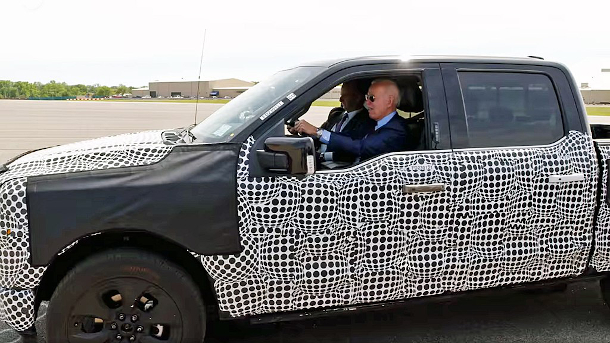
President Joe Biden test drives the Ford F-150 Lightning all-electric pick up. (Photo: The White House, public domain)
CURWOOD: Maybe a homerun. Well, I have to say the president looked like a teenager behind the wheel of a, I don't know, back in the day, a Pontiac GTO or something. He was so excited to hit the accelerator, which I guess is pretty astonishing, right? I mean, this thing moves.
MOTAVALLI: Well, Steve, one of the big advantages of electric vehicles is how fast they are off the line. Even the most pedestrian EV can give you very nice performance zero to 60. They have 100% of their torque available at zero RPM, which is why they make very effective drag racers. There's many videos of Teslas beating muscle cars in drag races. You know, the top speed may not be the same, but off the line, they are very impressive, which is why I'm sure Biden had fun driving one of those.
CURWOOD: So how big a deal is this now for Ford to be manufacturing this truck and sounding like they're gonna be first to market with an electric truck for this most popular of American trucks. So just how big a deal is this?
MOTAVALLI: I think it's a very big deal. I mean, right now, sales of plug-in vehicles are only at about 2% of the market. So in terms of actually cleaning up America's skies, getting gasoline out of the matrix, all that stuff, it's not really happening yet. But it's possible that this will become the first really big seller nationwide. I mean, you can look at the sales of Tesla, which is also extremely game-changing, because they've largely been dominating the luxury market. And you have to say that all the makers of the supercars have noticed that people are buying Tesla's instead of a lot of the other options like Ferraris or something. Because your Tesla can actually be faster than the Ferrari you buy. And it's why all the supercars are talking about switching to electric motors now, you can really get a lot more bang for the buck, as they say.

A lineup of Tesla vehicles, with the Cybertruck front and center. (Photo: Steve Jurvetson, Wikimedia Commons, CC BY 2.0)
CURWOOD: Let's talk about the money for a moment. They're going to sell this for $40,000. And by the way, where does the electric car tax credit fit into this?
MOTAVALLI: All the analysts were expecting it to be more because all the other electric pickups, and there are seven of them that are coming, are all priced way above that. The tax credit actually makes this even a better deal. Because on the F-150 Lightning, you can get a federal income tax credit of $7500, which takes the price down to like $33,000. You know, any SuperCrew pickup for 33 is a good deal. But with all the features on the electric, it's like a home run. It's not surprising, they've taken like 40,000 advance orders for this thing. I'm not surprised by that at all. And I think for instance, General Motors is coming out with a Silverado electric. The only thing they've really said about it is that it's going to have 400 miles of range. The price point is unknown. But they've got to take a look at what Ford just did, and they're probably drastically reducing the price they plan to ask because of this. Because you have other startups; Rivian is one, Bollinger is another. The Bollinger truck, which is going to be on the market in a year or so, that has a $125,000 price tag on it. So that's expensive.
CURWOOD: Yeah.
MOTAVALLI: And General Motors also announced an electric version of the Hummer. And that is going to start around $70,000, so that's why I thought maybe the F-150 Lightning would be a lot more. But by coming in so low, they really have changed the market, I think. Everyone was expecting it to be a lot more expensive and if you expect Ford to make a profit, it probably would be more expensive, because of how much batteries cost. There's maybe 110 to 150 kilowatt hours of battery on this thing. And that's going to be expensive. So my guess is they're probably losing money, at least initially. But that's how a company like Toyota ended up dominating the hybrid market by offering the Prius, probably a money losing proposition initially.

The Rivian R1T pickup at the 2018 LA Auto show. (Photo: Richard Truescell, Wikimedia Commons, CC BY-SA 4.0)
CURWOOD: So now what plans, if any, does Ford have on providing charging infrastructure around the country for these customers, so folks that have a pickup truck, it's all electric, it goes like a bat out of Hades. But you got to plug it in someplace?
MOTAVALLI: Well, yeah, it's hard to beat Tesla's charging network. One of the best things that Tesla did was to establish what they call the supercharger network across the country. And you can easily now - and initially, it was free, it's not always free now. But for certainly the initial buyers of the Tesla Model S, you got free charging across the country, and its high voltage, 400 volt charging, DC fast charging, which means that you could recharge in about half an hour. So you could and people definitely did drive their Teslas across the country. Now, Ford does not have any kind of network like that. But they said I believe in the announcement that they were going to have access to something like 60,000 chargers, I don't know, there was a big number, but they didn't give any details about that, how that's going to work.
CURWOOD: What have you seen if anything, as a reaction from Ford customers, or indeed other auto aficionados and, and truck drivers?
MOTAVALLI: Well, truck drivers are the ones ordering 40,000 of them. So I think they like it, I mean, it seems like they will. It did seem to me initially, that the traditional Ford truck buyer might be somewhat resistant to this. I mean, maybe they've owned like 10 generations of the F-150. And they're used to it being a certain thing. And this is a big departure from that. But I think they're going to be enticed by the features. There have been various hybrid trucks that have been on the market. But they only add a tiny bit of fuel economy, and they cost more. I don't think they were going to change the history and the hybrids are basically transitional technology anyway. I think we're going to finally see some serious sales with this vehicle.
CURWOOD: So Jim, come the end of the day, what role do you think electric trucks like the Ford are going to play in the future of the electric vehicle market?
MOTAVALLI: Well, you have to just sort of look at the vehicle market overall, which has shifted largely to pickups, and trucks and SUVs. So the American consumer definitely likes those formats. To the extent that Ford is largely not in the car business anymore. It's basically in the SUV and truck business. In a stunning, I thought it was a stunning move, they announced they were going to kill all their car lines except the Mustang. And that was crazy. But then they come out with a new version of the Mustang, which is the Mustang Mach-E, which is their electric car. And that's also very credible. So where they hadn't been all that credible in gas vehicles, suddenly, they're credible with electric ones, because both the Mach-E and the new F-150 Lightning, they're both very credible in the EV space. So it could transform what Ford is, as a company, I think it's going to be in a very short time will be all electric. And that is in line with a lot of other automakers' plans. For instance, Volvo said it's going to be all electric. Jaguar said it's going to be all electric. Bentley said it was going to be all electric. I mean, some vehicles, you wouldn't really expect to be electric, they're going in that direction.
CURWOOD: All right, Jim. So, look into your crystal ball. Tell me what's the future now of electric cars here in the United States.
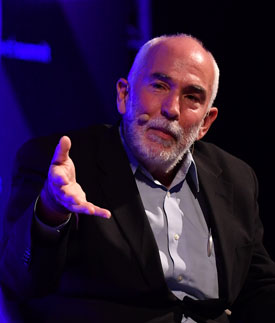
Jim Motavalli is a freelance environmental journalist and blogger for NPR’s Car Talk (Photo: Seb Daly, Web Summit, Wikimedia Commons, CC BY 2.0)
MOTAVALLI: I think the future is very set, I don't have to have a crystal ball for this, because you can just look at what the automakers have said they're going to do and they're going to switch to all electric vehicles, they're gearing up. Most of the auto manufacturers, the major ones, they're no longer doing new engine programs. They're not, say commissioning a new V8 or a new V6 engine, it would be pointless. It would only be on the market for a year or two. So instead, the engines we've got now are pretty much the ones we're going to have. They're not going to build anymore. So they're putting way more money into electrification than they are into continuing the internal combustion vehicle. The exact timetable is a little unclear, but I would say by 2035, I think we're going to see pretty heavy concentration of the market be electric, and maybe by 2040, we won't have any internal combustion cars on the market. It's still slower than we probably need it to be for climate change and other reasons, but I do think that pivot is now inevitable and it doesn't need government regulation or mandates. It's going to happen.
CURWOOD: Jim Motavalli is a car writer for Sierra Magazine and blogs for NPR's Car Talk and writes for the New York Times. In fact, any place where you might encounter an article about cars, you might see something written by Jim Motavalli. Jim, thanks so much for taking the time with us today.
MOTAVALLI: Thanks for having me on.
Related links:
- Click here to learn more about the Ford F-150 Lightning
- Forbes Wheels | “7 Electric Pickups On The Horizon, Including Ford F-150 Lightning”
- More About Jim Motavalli
[MUSIC: Bill Withers “Lovely Day” on Lean On Me: The Best Of Bill Withers, Sony Music Entertainment]
The EV RX

New research suggests that the adoption of electric cars could improve health outcomes. (Photo: American Tobacco Campus, Flickr, CC BY-NC 2.0)
CURWOOD: We know that electric vehicles like Ford’s new F150 can be good for the environment. They can produce significantly fewer greenhouse gas emissions than gas and diesel ones, regardless of the makeup of the power grid that charges them. Now, new research suggests that EVs are also better for our health. Scientists found a reduction in pollution with the adoption of electric vehicles will likely reduce mortality and illness. Professor Jack Spengler was on the research team and he joins us from the Harvard T. H. Chan School of Public Health. Welcome to Living on Earth.
SPENGLER: Well, thank you, Steve, glad to be here.
CURWOOD: So, how excited are you by this research? In other words, how important to our health is the advent of electric cars or nevermind the greenhouse gas effects.
SPENGLER: So they're extremely helpful to our health. And when you think about urban congestion, and you think about the vehicle miles traveled in close proximity to people, let alone the people in the cars themselves on the road, that we get a tremendous exposure over the course of our lives from these nearby sources, roadside emissions, effectively, it's a we make that fleet cleaner, we all benefit from healthier air.
CURWOOD: So some people say, hey, you have an electric vehicle, if a coal fired power plant is driving that electric vehicle, what improvement is there? And your research would say?
SPENGLER: So it turns out that if you remove the emissions at street level, where people are, and that's where the cars are generating, you have tremendous savings in reduced exposures and health benefits. Of course, you've got to charge those batteries, right? And that comes from the power grid. And the power grid is not concentrated in urban areas. It's in more rural areas, it's more dispersed from high stacks, spreads out over big populations. But the net is that you actually have a net benefit.

Gas-powered cars emit pollution, such as particulate matter and volatile organic compounds. (Photo: Biofriendly, Flickr, CC BY 2.0)
CURWOOD: Now, what kind of benefit are we talking about here in terms of mortality? Recently, there were studies showing that some 300,000 people a year in this country die from excess deaths related to the burning of fossil fuels. I think that includes vehicles, but also other combustion of fossil fuels. What do you know about the transportation sector's contribution to disease and mortality?
SPENGLER: Well, as we start to make the grid cleaner, and that is happening, decrease in coal fired power plants, cleaner burning gas, now renewables coming in. So the proportional impact of motor vehicles is getting larger. In fact, it is contributing 20 to 30%, as I recall, to that mortality from air pollution,
CURWOOD: Talk to me about what we know about these pollutants, these are tiny particles, you call them PM 2.5 for their size, 2.5 microns. Talk to me about them and their health impacts.
SPENGLER: Well, size makes a big difference because size of these particles shows where it ends up in the respiratory tract, right? Our nose can filter out bigger things, our respiratory tract can deposit particles and remove them. But small ones get deep into the lungs. And that's where they're more important. But when we talk about vehicle emissions, you know, they do put out some primary particles, but they put out gases, they put out nitrogen oxides, and VOC's, volatile organic compounds. They put out ammonia. And these can convert into particles. So they go through chemical reactions, and they start forming or adhere to particles. So they become part of the particulate material that we inhale. And then further downwind from these emissions, you can produce ozone from the nitrogen oxide precursors that are coming out of vehicles.
CURWOOD: How can policymakers take advantage of the research that you've done here? What are the practical implications do you think?

Jack Spengler is the Akira Yamaguchi Professor of Environmental Health and Human Habitation at the Harvard T. H. Chan School of Public Health. (Photo: Courtesy of Jack Spengler)
SPENGLER: Well the implications of policymakers, I think are several. One is you now have a calculation, rather robustly done, that says what incentives should we offer to encourage the purchases of electric cars. In particular, if we replace an older, dirtier vehicle with a new electric vehicle, the benefits are substantial. So the subsidies of $7,000 per purchase, are probably right on point with the public health savings that result from that. The second thing I think it tells us is that beyond federal controls, federal emission controls, federal CAFE standards, fuel efficiency standards, cities can make a big difference in what their policies could be. So the cities could look at various ways of traffic calming, of electrifying certain portions of their fleet that are in those cities more frequently. And so they could use the results to come up with new strategies at the municipal level. Policymakers should be mindful of the need to consider environmental justice and social justice. Because if one actually had a policy or a program that provided incentives to remove the dirty, the old clunkers right? The dirtiest cars from those urban streets, replacing them with electric vehicles incentivizing to be replaced with electric vehicles. There's going to be tremendous benefits to those people that currently have the worst air pollution.
CURWOOD: Jack, we only have 2 to 3% of vehicles in the United States right now are electric. How long do you think it will take to get to scale? Well, this will have really a meaningful impact on health as well as the climate.
SPENGLER: So I looked at some data from major auto companies and what they're investing to convert their manufacturing. I mean, $30 billion for Ford, $27 billion General Electric *General Motors, unbelievable, Volkswagen over five years $80 billion, and they're projecting major portions of their sales by 2025, 2030 will be electric vehicles. So it's happening fast. I think the question is, is it happening fast enough? And my answer would be no, we should've started this a decade or two decades ago, when we had the first electric car put out by General Motors.
CURWOOD: Jack, thanks so much for taking the time with us today.
SPENGLER: Well, thank you so much, Steve. This is a message that I think is important to get out.
Related links:
- Read the study: “Assessing the health impacts of electric vehicles through air pollution in the United States”
- Harvard T.H. Chan School of Public Health | “How Harvard Chan School Researchers Are Taking Action on Climate Change and Fighting for a Healthier, More Equitable Planet.”
- Jack Spengler’s bio
[MUSIC: The Cars “Drive” on Heartbeat City, Asylum Records]
CURWOOD”: Coming up – Roadsides can be critical habitat for pollinators. Keep listening to Living on Earth.
ANNOUNCER: Funding for Living on Earth comes from you, our listeners, and United Technologies, combining passion for science with engineering to create solutions designed for sustainability in aerospace, building industries, and food refrigeration.
[CUTAWAY MUSIC: Arturo Sandoval “Blues in F” on My Passion For The Piano, Crescent Moon Records]
Backup: African Elephant and Chacma Baboon

The Elephants’ Junior frolicking. (Photo: © Mark Seth Lender)
CURWOOD: It’s Living on Earth, I’m Steve Curwood.
We travel now to Matobo National Park in Zimbabwe with Living on Earth’s Explorer in Residence, Mark Seth Lender.
"Backup"
African Elephant & Chacma Baboon
Matobo National Park
LENDER: The chacma baboons are awake. Their calls echo out of the caves in the kopjes, bouncing off the rounded boulders of which the kopjes are made and down towards the waterhole below.
Ur-RAU! Ur-RAU! Ur-RAU!
Ur-RAU…
Down, and down, the chacma baboons come to drink, using all four limbs that are both hands and feet. They come in the narrow slot when it is light enough to see but just before sunrise when it quickly becomes too hot.
Ur-RAU! Ur-RAU!
As much as it is only a wake-up call it is also an announcement.
Along the edge of the waterhole The Elephants’ Junior now approaches the drinking baboons. For The Elephants’ Junior, hardly more than a baby, they are just another means and method of amusing himself. He harangues them with his trumpeting, stamps his feet, flaps his ears, waves his little trunk. He is hardly formidable but he is bigger than they are and that is usually enough.

An olive baboon, closely related to chacma baboons. (Photo: © Mark Seth Lender)
The baboons know what his game is, and most of them leave.
Most of them.
Not The Baboons’ Biggest.
The Baboons’ Biggest is large even for a chacma baboon and all he does is give The Elephants’ Junior, a look.
The Elephants’ Junior’s eyes grow wide. He leans back stopped in his tracks (like a cartoon character putting on the brakes except for the lack of dust and sound effects). And realizes what he’s up against. And that he’s made… a mistake.
Behind The Elephants’ Junior, unnoticed by him, The Matriarch’s Sister, seeing what has transpired (or is about to) ambles over. She stands well behind The Elephants’ Junior, silent and very still. There is no tension in her demeanor, all she has done is to make herself present.
And now The Baboons’ Biggest is looking not at The Elephants’ Junior but at her.
The Elephants’ Junior, following the gaze of The Baboons’ Biggest, glances behind him, but his demeanor does not change, because -

The Matriarch’s Sister to the rescue. (Photo: © Mark Seth Lender)
Even now The Baboons’ Biggest is reluctant to leave, making it apparent just how much he would like to take a piece out of that little elephant. But he is not stupid. The Baboons’ Biggest glances at The Elephants’ Junior one last time as he turns, and slinks up the hill and into the kopje. And The Elephants’ Junior in triumph kicks dirt after him in his retreat.
No one will be bothering The Elephants’ Junior.
Not today!
CURWOOD: That’s Living on Earth’s Explorer in Residence Mark Seth Lender.
Related links:
- Read the corresponding Field Note
- Mark Seth Lender’s website
- Special thanks to Destination Wildlife
Running Buffalo Clover

The plants with the white flowers are the endangered running buffalo clover (Trifolium stoloniferum), among various other plants. (Photo: USFWS, Flickr, Public Domain)
CURWOOD: There are more than 50 different species of clover in the US. Glynis Board from the Ohio Valley ReSource has this story about a rare clover once thought to be extinct.
BOARD: It's a plant we all know and love, or we think we do. The clover. But one species of clover was thought to be extinct until someone found it in West Virginia 30 years ago. Biologist Rodney Bartgis recalls his discovery was met with some skepticism.
BARTGIS: We were walking along the trail and I told Clois, hey there's running buffalo clover. And he said, no, it's extinct. I said Clois, that's it and he bet me a steak dinner that that was not running buffalo clover. And I got that steak dinner. So that's how it was rediscovered.
BOARD: After Bartgis reported the find, running buffalo clover was moved on to the endangered species list. Today he's hiking with Melissa Thomas-Van Gundy, a research forester with the Forest Service stationed here at the Fernow Experimental Forest in West Virginia. That's one place where you can find the clover.
THOMAS- VANGUNDY: Part of the running part comes from these stolons. These plant parts that are like a strawberry runner.
BOARD: For years, Thomas-VanGundy has been helping to manage the populations of running buffalo clover found here.
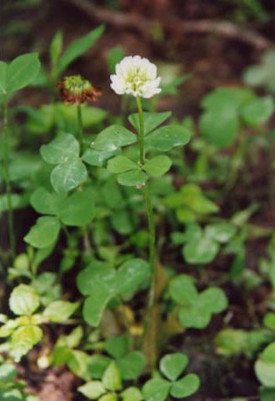
Running buffalo clover (Photo: Sarena Selbo, USFWS, Wikimedia Commons, Public Domain)
THOMAS- VANGUNDY: Of course, it's not blooming right now, but that is a really good way to identify it.
BOARD: These clover are not like the ones you find in your yard. They're much more sensitive. They can't tolerate full sun, full shade or severe disturbance. That said Thomas- VanGundy explains they love heavy machinery. She explains that in this particular tract of land, forest managers use heavy machinery every 10 years or so on paths they call skid roads.
THOMAS-VANGUNDY: When we first found this. I think it was along this trail somewhere. We say okay; well Fish and Wildlife Services says, you guys can't disturb those plants, put your skid road up there. Don't use this skid road. Okay, we did that. Came back in, plant numbers had dropped where we hadn't run over them. It showed up on the new skid road. So it's kind of a frustrating plant. If you think you have to stay off of it.
BOARD: The US Fish and Wildlife Service listed the clover as endangered in 1987. Since then, more populations have been found and monitored. Today about 150 populations are known to exist in six states. Many of these populations are on public lands or they're on private land with conservation agreements. Thomas Van Gundy and Bartgis say protecting these rare plants is an important part of maintaining the protective benefits of biodiversity. They say a more diverse forest is more resilient to disease, pointing out that humans ultimately depend on healthy ecosystems for clean air and water. But Bartgis says his motivation to protect the running buffalo clover is also rooted in the value of the stories it tells.
BARTGIS: Just imagine standing right here and a herd of mastodon comes through. We know that that happened fairly routinely. That's what this, that's the disturbance making that most of the species evolved in. So you know, once the mastodons and things like that died out, they relied upon, you know the Buffalo and elk so we can go back to that story. And now they rely on us.
BOARD: When asked if he thought delisting the clover was a good idea Bartgis said he felt all right about it. But the running buffalo clover isn't quite out of the woods, so to speak. Bartgis pointed to stilt grass and other invasives that could displace more delicate native species. So it's important he adds to continue to keep an eye and maybe a reintroduced elk hoof on them. I'm Glynis Board in the Fernow Experimental Forest in West Virginia.
CURWOOD: Glynis Board’s story comes to us courtesy of the Ohio Valley ReSource.
Related link:
This story from The Allegheny Front via Ohio Valley ReSource
Roadsides as Vital Habitat
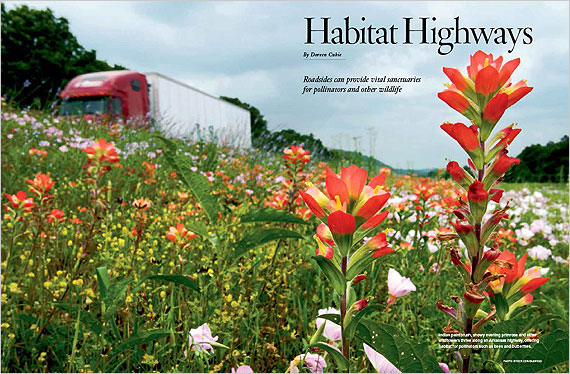
The National Wildlife Federation recognizes roadsides as vital sanctuaries for pollinators and other wildlife. (Photo: courtesy of NWF)
CURWOOD: Clover is a crucial source of nectar for many pollinators, especially bees. And as national pollinator week is coming up on June 21 it’s a good time to think about the many ways we can help our endangered pollinators, starting with our highways.
It turns out that medians and roadsides offer miles and miles of vital habitats for many pollinators including bees and butterflies. Bonnie Harper-Lore was a restoration ecologist for the Federal Highway Administration, and is a member of the Commission on Minnesota Resources. Welcome to Living on Earth, Bonnie.
HARPER-LORE: Greetings, Steve, how are you?
CURWOOD: Good. Thanks for joining us today. Now, we're talking about those strips of vegetation along the highways. There's often commercial or residential property right behind them. So, nationwide, just how much of this habitat is there?
HARPER-LORE: Well, I think the listeners will be surprised to find out that the area between the pavement and the right of way fence on county, state, and interstate highways adds up to a total of 17 million acres, possibly millions of acres of conservation opportunity.
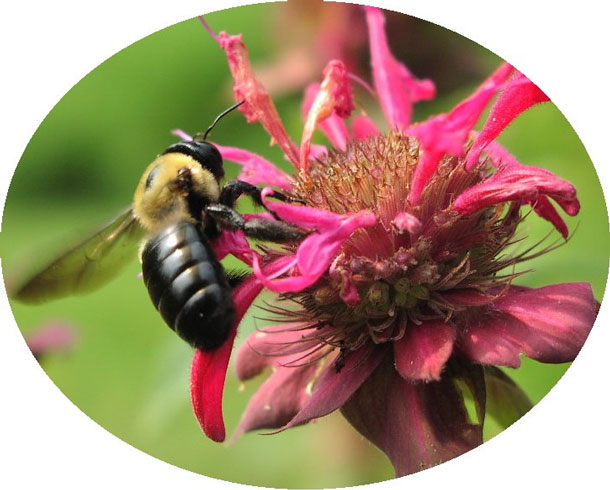
Bees are some of the pollinators that depend on roadside habitat. (Photo: Beatriz Moisset / USDA)
CURWOOD: So what do we have to celebrate in terms of roadside habitat for pollinators now?
HARPER-LORE: Well, the fact that it’s a news item at all is something I'm celebrating because I always saw roadsides from the beginning of my career 30 years ago as an opportunity to benefit wildlife, small wildlife, small birds, small mammals, and migrating birds also use these same corridors. So if they have places to find food and cover, they are all going to do better and their populations will continue to hold where we need them to hold.
CURWOOD: By the way, I also understand that this roadside habitat has some of the most endangered habitat in various areas – like there are parts of the original prairie that are protected alongside roads, sort of by accident. You can sometimes find real old-growth trees. I mean, how much of a treasure trove is this territory?
HARPER-LORE: Well that's just it: We don't have a complete inventory of all of our roadside vegetation. I would indeed like to see that happen because I think we would be surprised at how many remnants of these old forests, old prairies, old wetlands even do exist. We began doing a bit of that inventory in 1993 in California – found 19 remnants within a very short time and began protecting them, managing differently, not mowing and spraying as they had in the past. So there are some of these. I mean, it's surprising that they do exist. I know Florida has also some endangered, I believe, pitcher plants that are growing in their rights of ways and they are now watching over them differently than they have in the past. So if we know they're there we can do differently.

Monarch butterfly caterpillar feeds on milkweed. Along Interstate Highway 35, a 1,568-mile-long road between Duluth, Minnesota and Laredo, Texas, Monarch habitat is being preserved. (Photo: Marshal Hedin, Flickr CC BY-SA 2.0)
CURWOOD: So, give us the big picture as to who are the partners in these pollinator conservation efforts.
HARPER-LORE: Well, first of all, before President Obama visited Mexico and talked to President Nieto and Prime Minister Harper from Canada and they agreed to work together to protect Monarchs – before that point there were actually a few states that were doing pollinator-focused efforts. Wisconsin comes to mind in that the Karner Blue butterfly is an endangered species and they actually put together, I believe, a 20 member partnership quite a few years ago to protect the Karner Blue and that partnership was mostly private sector but some state and county agencies, too, and they've done a great deal to keep the Karner Blue safe in Wisconsin. So those kinds of things have happened individually but you have to realize every state Department of Transportation basically does its own thing, makes its own priorities but now. Now that there's been a White House task force there has been a pollinator-enhancing bill, a reauthorization act that actually supports pollinators, all of the states will start moving in that direction, especially if they know the public is interested. So public support needs to be there.
CURWOOD: Tell me about the multistate project known as the I-35 corridor, and what's been done in terms of Monarch protection there?
HARPER-LORE: Well, ironically back in 1993, a group of six states asked the Federal Highway Administration, where I worked at the time, to work together and get some funding to support their effort to actually restore prairie along the I-35 corridor and to protect any remnants that already existed there.
CURWOOD: And remind us where the I-35 corridor is.

Ladybird Johnson, First Lady during the Lyndon Johnson administration of the 1960s, spearheaded the Highway Beautification Act. (Photo: Frank Wolfe / LBJ Library, Wikimedia Commons Public Domain)
HARPER-LORE: It runs from Minnesota through Iowa, Kansas, Missouri, Oklahoma and Texas, therefore connecting Mexico to the edge of Canada and of course that's where the Monarchs fly.
CURWOOD: What other wildlife uses this roadside habitat? You know, you often see hawks hanging out there. The hunting must be pretty good for them, I guess?
HARPER-LORE: It certainly is. I watched hawks, all kinds of raptors, sitting on the light standards along highways and signposts just waiting for lunch to materialize down there in the vegetation on the roadside. Yes, they do well there because there are lots of mice and voles, other small things possible, plus one that actually motivated reduced mowing here in the Midwest, pheasants and other waterfowl, different kinds of ducks will nest in these rights of ways. So, it's amazing, when you're screaming by at 55 to 70 miles an hour, what's happening out on that green strip that you probably will never ever imagine.
CURWOOD: Lady Bird Johnson, first lady during the Lyndon Johnson administration, her signature cause was highway beautification back there in the 60s. What kind of impact – what kind of lasting impact – has her work had on roadside pollinators do you think?
HARPER-LORE: Well, I smile because it's because of Lady Bird Johnson that my job even existed with the Federal Highway Administration. I was working for the Minnesota Department of Transportation establishing their wildflower program back in the 1980s when I got an invitation from Mrs. Johnson to come visit with four other states who were also interested in planting wildflowers and we sat and talked with her for two days, and the thing we didn't know she would do -- because she asked us what did we need to be able to do more -- within that same year, she saw to it that there was an amendment to the transportation bill that requires all states to use certain percent, not a large enough percent, but a certain percent of their budgets on native wildflowers. So, a few years later, I was looking for a job and I talked to the people I had met at Lady Bird Johnson's and they said there's an opening in Washington and within a few months I was able to be in charge of the national wildflower program. Thanks to her, we've come some distance. I've had people write me with their thank yous for the wildflower program over time. One of them was an 18-wheel truck driver who said, ‘thank you for the wildflower program, I drive from coast to coast and it helps me...gives me something to look at and keep me alert and awake’, and I was like, ‘what a surprising thank you letter that was.’ And there are others too. I have a file full of them.
CURWOOD: Bonnie Harper-Lore served in the Federal Highway Administration as a restoration ecologist. She is now with the Commission on Minnesota Resources. Bonnie, thanks for taking the time with us today.
HARPER-LORE: You're welcome. Thank you for what you do.
Related links:
- The I-35 Corridor To Become a Habitat For Bees, Monarch Butterflies, and Other Pollinators
- A Transportation Research Board webinar about how roadside mowing affects pollinators
- Bonnie Harper-Lore serves on the Legislative-Citizen Commission on Minnesota
- Tips for preserving roadside habitat from the Xerces Society for Invertebrate Conservation
- Green Highways: New Strategies To Manage Roadsides as Habitat
[MUSIC: Alexis Cohen “It Might As Well Be Spring”]
CURWOOD: Living on Earth is produced by the World Media Foundation. Our crew includes Naomi Arenberg, Bobby Bascomb, Paloma Beltran, Anna Canny, Jenni Doering, Jay Feinstein, Mark Seth Lender, Don Lyman, Aynsley O’Neill, Jake Rego, Joshua Siracusa, Tivara Tanudjaja and Jolanda Omari. We say goodbye this week to our interns Grace Callahan and Natalie Seo. Thanks for your excellent work. You’ll be missed! Tom Tiger engineered our show. Alison Lirish Dean composed our themes. Special thanks this week to Destination Wildlife. You can hear us anytime at L-O-E dot org, Apple Podcasts and Google Podcasts, and like us, please, on our Facebook page - Living on Earth. We tweet from @livingonearth. And find us on Instagram at livingonearthradio. I’m Steve Curwood. Thanks for listening!
ANNOUNCER: Funding for Living on Earth comes from you, our listeners, and from the University of Massachusetts, Boston, in association with its School for the Environment, developing the next generation of environmental leaders. And from the Grantham Foundation for the protection of the environment, supporting strategic communications and collaboration in solving the world’s most pressing environmental problems.
ANNOUNCER 2: PRX.
Living on Earth wants to hear from you!
Living on Earth
62 Calef Highway, Suite 212
Lee, NH 03861
Telephone: 617-287-4121
E-mail: comments@loe.org
Newsletter [Click here]
Donate to Living on Earth!
Living on Earth is an independent media program and relies entirely on contributions from listeners and institutions supporting public service. Please donate now to preserve an independent environmental voice.
NewsletterLiving on Earth offers a weekly delivery of the show's rundown to your mailbox. Sign up for our newsletter today!
 Sailors For The Sea: Be the change you want to sea.
Sailors For The Sea: Be the change you want to sea.
 The Grantham Foundation for the Protection of the Environment: Committed to protecting and improving the health of the global environment.
The Grantham Foundation for the Protection of the Environment: Committed to protecting and improving the health of the global environment.
 Contribute to Living on Earth and receive, as our gift to you, an archival print of one of Mark Seth Lender's extraordinary wildlife photographs. Follow the link to see Mark's current collection of photographs.
Contribute to Living on Earth and receive, as our gift to you, an archival print of one of Mark Seth Lender's extraordinary wildlife photographs. Follow the link to see Mark's current collection of photographs.
 Buy a signed copy of Mark Seth Lender's book Smeagull the Seagull & support Living on Earth
Buy a signed copy of Mark Seth Lender's book Smeagull the Seagull & support Living on Earth

